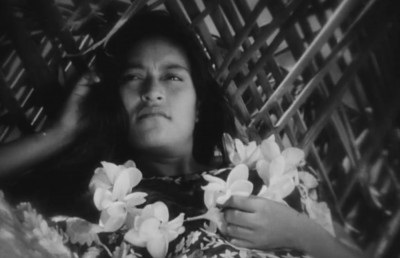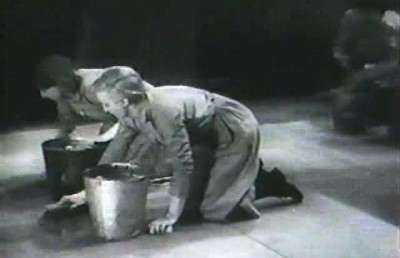Eisenstein’s Film-Symphony Project, Que viva Mexico! Part 2: Music
Eisenstein and Sound

When writing scenarios Eisenstein explained that he liked “to imagine the music as I work.” (Eisenstein 1995, Vol. 3, 69). Together with his skill and imagination in the visualisations of the events in his film projects, Eisenstein simultaneously had an ability to aurally imagine the music and sound in them. In this respect he worked like a composer, who before composing the music for an opera reads the libretto and aurally imagines the types of music which are needed at each point and for each scene. At times Eisenstein would even refer to his scenario as a ‘libretto’, as he did in 1939, when he sent his detailed outline for the Ferghana Canal film project to Prokofiev, when he was asking him to compose the music for it (Bergan 307). In his most detailed scenario for Que viva Mexico! there are very few examples of speech or dialogue. Most of the text is descriptive, and suggests two main sources of sound: there is music which always comes directly and organically out of the events which occur, and noise, which has a similarly direct relationship to what is happening. Both of these types of sound are closely related to the strongly traditional nature of the various Mexican cultures which form the context of each episode in the film. It is almost as if there are two scores implied throughout the scenario: a score for the music, and an equally important score for noise.
Eisenstein’s idea to use a symphonic form for Que viva Mexico! enabled him to structure a series of four highly contrasting narratives, akin to symphonic movements, framed by a Prologue and an Epilogue. A classical symphonic structure depends on the formal principle of four highly contrasting movements. These differ from one another in a variety of ways: in tempo, in style, in content. Like each narrative in Que viva Mexico! each symphonic movement is largely formally self-contained, though they can be linked by certain recurring elements. For example two of the four movements can have elements in common, in the same way that the Maguey and the Soldadera episodes are linked by the themes of violence and death, and the Sandunga and Fiesta episodes are linked by sharing a romantic and lyrical atmosphere. In addition, each of the six parts of the film features a different folk-song. Eisenstein is concerned that together, as “songs, legends, tales from different parts of Mexico” they form a symphonic unity. He is aiming to bring together these different parts of the country into “one unified cinematic work,” a ‘Film-Symphony’ which for him represents the varied entity of Mexico, audiovisually (Karetnikova 37).
For what Eisenstein calls his ‘overture’, the Prologue set in Yucatan, he uses “the quaint rhythm of the drums” and “the high-pitched Maya song” to accompany the funeral procession which has been frozen in time (Karetnikova 40). This music is intended to evoke a sense of primordial timelessness, an elemental combination of high voices and drums, to provoke a state of trance in those attending the funeral. (*The Mexican composer Carlos Chávez used a similar sound palette in Xochipilli (1940), his attempt to imagine what Aztec music might have been like. This short work is scored for flutes in a high register, Eb clarinet, trombone, together with a variety of percussion instruments, mostly drums. Chávez composed this piece after reading accounts of Aztec music, as well as drawing on his memories of the music of the Indian ensembles he had heard in the country as a child. He states that a variety of Aztec instruments can be used to play Xochipilli, if they are available (Chávez 1).
The first episode is named after the Sandunga, a graceful dance song from the Isthmus of Tehuantepec, which reflects the rich mixture of cultures Eisenstein describes in his scenario. It is a mixture of the European waltz, as well as Spanish and Zapotecan musical styles (score, arr Chavez: Mexico South, 326, Covarrubias). The song is the expression of a Zapotecan woman’s grieving over the death of her mother; she moves from an overwhelming sadness to a sense of release afforded by the acceptance of her loss. The girls from Tehuantepec sing the Sandunga as they lie in the shallow edge of the river at the start of this episode. The sensual music of this danced song is present almost continuously throughout this story. It embodies the slightly unreal and dreamlike quality characteristic of the Sandunga episode (Karetnikova 54, and text of Sandunga from Covarrubias’ Mexico South).
Music is used to frame the beginning and end of the Maguey ‘novella.’ The morning hymn, El Alabado, is sung by the peons before they leave the hacienda to begin their day’s work harvesting the sap of the maguey cactus. A song to the virginity of a new day, it is at the same time a hymn to the Virgin Mary, another example of the Mexican mix of Mesoamerican and Catholic cultures and beliefs (Karetnikova 76). Eisenstein closes the episode with the peons singing “their vesper song just as plaintive, as mournful, as their morning Alabado.” After the violence of this section, the music has a cathartic effect, and also gives a sense that nothing has changed (or will change) in the static feudal rhythm of the life of the Mexican haciendas, the “unapproachable fortresses amidst the vast seas of cactus groves.” The only other music Eisenstein mentions in this stark episode is the ‘rattle’ of the dance music for the hacienda’s annual fiesta, ordered by the feudal lord as a distraction after the incident of the rape of the peon’s bride (Karetnikova 76,78,79).
The Fiesta section features a more complex and varied selection of different pieces of music, to match the complex visual patterns in the episode. As pilgrims from all over Mexico gather for the national fiesta in honour of the Virgin of Guadalupe, the matadors prepare for the bullfights to the accompaniment of “the tinkling of guitars and the sound of militant songs of the ring.” An orchestra at the bullring accompanies the opening parade with a joyful march as the audience take their seats. Overlapping with the end of the corrida there is a complex mix of rhythms as the drums of the Indian ceremonial dances, the pealing of the ancient Spanish church bells and the ‘thunder of exploding sky rockets’ combine in the plaza, punctuated by the roar and ovations of the crowd from the bullring. Here again is an audiovisual expression of the Mexican blend of Mesoamerican and Catholic cultures; in this instance the non-Christian aspects of Spanish culture are also shown in the bullfighting rituals. Then there is another mix: Spanish and African influences merge in the music for guitars and marimbas which accompany the lovers’ retreat into the labyrinth of the floating gardens of Xochimilco. Then, following the picador’s narrow escape from the jilted husband, a song from the huge fiesta ends the episode (Karetnikova 96,97,98).
The song Adelita dominates the story of the soldadera, the women soldiers who fought alongside and supported the troops during the period of the Mexican Revolution, after 1910. A combination of various exploits of different soldadera is thought to have been at the origin of the semi-legendary subject of this song, Adelita (a diminuative of Adela) (accessed February 16, 2004). Because of the song’s popularity with the troops, like the song Lily Marlene in World War II, it was sung by opposing sides (accessed February 16, 2004). Eisenstein calls Adelita the leitmotif of the soldadera and so he presents it in different arrangements. It first appears scored for guitars, as the soldiers and the soldadera rest in the evening. Then the soldiers sing it in transit, on the troop train. After a battle during which her soldier is killed, the soldadera “under the burden of grief and weariness,” follows the army again. Another soldier carries her child for her and he becomes her new partner. This action takes place against the backdrop of another version of Adelita, this time played by military bands, out of tune and out of rhythm, evoking the weariness and depression of the soldiers and the soldaderas. When they learn that the civil war is now over, at this point Eisenstein has a military brass band play Adelita in its final appearance ‘stoutly, solemnly and triumphantly’ (Karetnikova 129,131,132).
Eisenstein’s ideas about the use of music for the Epilogue to Que viva Mexico! are to be found in his introduction to the scenario for the film, which he wrote in 1947, for inclusion in the planned publication in French of his writings and scenarios (Seton 504). For the Day of the Dead masks and skeletons he had planned a ‘final joyous farandole’ to which all the characters from the previous episodes would dance, as well as figures from Mexico’s past and present (Seton 510). In another text on this subject, Eisenstein points out that the living are also featured in these masked dances of the dead, in this case ‘a wild rumba’ (Eisenstein 1995, 632). Traditionally, one speaks well of the dead, but there is nothing to prevent Mexicans from using the mask of death during these annual festivities, to satirise the living: “carnival death demands malicious, heartless, venomous epigrams for each quasi-corpse, to tear off the veneer he sports in life” (Eisenstein 1995, 633). It is this Day of the Dead tradition which Eisenstein uses in the climax of his film. All appear equal in death – both in the actual All Saints Day fiesta and in Eisenstein’s Epilogue, people at all levels of society rub shoulders as dancing skeletons. The Que viva Mexico! characters blend in with the masked dancers from an actual fiesta. The living bishops and generals (and the living President of Mexico) were to have appeared in the documentary-style section at the beginning of the Epilogue (Seton 510). In the Day of the Dead conclusion, these dignitaries remove their masks to reveal “the grimace of a real skull,” (Eisenstein 1995, 634) whereas the ‘positive heroes’ from the film, those peons, soldiers, soldadera and others, whose lives are blighted by violence and slavery, a form of death in life, remove their skeleton masks to reveal ‘living, bronzed faces, creased with mirth’ (Eisenstein 1995, 632,633).
The shock of the dignitaries’ true death-like nature appears in the sudden pause Eisenstein noted in his experience of dances during an evening spent in a Mexican dance hall:
The ‘Danzon’ is under way, that amazing dance, in which from time to time, in the midst of the most sharp motion, a couple suddenly, for several beats, freezes completely motionless, facing one another, and stands as if rooted, until they again continue the tormenting sensuality, or the quick tempo of rhythmic body movements…At such moments, the dance hall is frightening: it seems like a stiffened corpse, still trembling inside to the beat of the orchestra’s screaming rhythm…In the semidarkness, the figures come to life and float away… (Karetnikova 170).
The pause traditionally found in the danzon or rumba, or any number of such kinds of dances from Mexico, the Spanish-speaking Caribbean and Latin-America, lies for Eisenstein at the meeting point between sensuality and death. This phenomenon enables him to weave a seamless pattern from these traditional dances and their personal and political significance to his audiovisual portrait of Mexico. The double death/life, life/death inversion already takes place during the annual Day of the Dead fiesta. All he has to do is select from what he has experienced in the various landscapes of the country, both rural and urban, and place these chosen elements, both visual and auditory, back into their original and ‘live’ contexts. This is why the Day of the Dead festival provides an ideal conclusion: it enables Eisenstein to refer directly and naturally to all the past events in his ‘libretto’, as death and its simulation is necessarily retrospective, even in the case of the popular epigrammatic judgements on the ‘living dead’ dignitaries. At the same time it enables him to finish on the optimistic image of a young boy’s smiling face, emerging from behind a cardboard mask of a skull, preceded by other smiling faces, uncovered in the same way, who represent the rebirth and continued life of Mexico. Presented audiovisually, at one and the same time this rebirth is the underlying theme of this fiesta and of Que viva Mexico! Now it can be seen why the version of the scenario which Eisenstein made available to the Mexican authorities (and sent to his financial backers the Sinclairs), did not include the musical element to be featured in the final part of the Epilogue, showing the Day of the Dead. With the Mexican authorities’ promise to lend Eisenstein hundreds of troops for the soldadera episode, it would not have made sense to have them know in advance that they were effectively to be represented in the climax of Que viva Mexico! as examples of the ‘living dead’ (Eisenstein 1995, Vol. 3, 47).
Noise in Que viva Mexico!
Together with Eisenstein’s indications regarding music in his scenario, there is also a ‘score’ which involves a use of noise which increases from scene to scene. The Prologue is characterised by an immobile silence of death, apart from the thin Mayan music of drums and high voice (Karetnikova 40). The Sandunga episode is framed by the sound of screaming parrots, with the noise of fireworks appearing at the wedding fiesta (Karetnikova 53,54). The same noise of fireworks is heard during the hacienda fiesta in the Maguey story, and these explosions are carried forward in the noise of the burning hay and the subsequent shooting between the peons and the charros (Karetnikova 57,78,79). In the Fiesta episode, the noise augments in scale with the sound of the shouting and hand-clapping of some sixty thousand people assembled on the plaza, waiting to enter the bullring’s auditorium. Their cries, outbursts and roars of derisive laughter punctuate the corrida. Then, outside the arena, the sound of exploding sky rockets is heard, as well as the sound of pealing church bells, mingling with another roar of the crowd and ovations. At this point the noise ‘score’ combines with the music, which itself has a strong noise element: the rolling of beating drums accompanying the Mesoamerican ceremonial dances in the plaza (Karetnikova 96,97).
The Soldadera episode is particularly rich in noise, starting with ‘yells, shouts, general havoc’ in a small Mexican village, as it is being pillaged by the women soldiers. Squealing pigs and screeching fowl can also be imagined at the beginning of this story: “…women are catching hens, pigs, turkeys; women are hastily seizing tortillas and chile in the houses” (Karetnikova 128). As the women set up camp and begin to cook, “the clapping of their palms, patting tortillas into shape, seems to announce peace.” Then, as the weary army arrives, ‘clarions sound the call to ‘rest.’’ After dinner the soldiers listen to the playing of Adelita on guitars, then fall asleep. The sleeping soldiers form a ‘snoring chorus’, recalling a similar chorus of snoring soldiers at the end of Act 2 in Alban Berg’s opera Wozzeck (1917-21). The next day there is a battle, with the sound of machine-guns roaring, the ‘clatter of cavalry,’ shouts, the noise of gunshots and exploding shells. After the battle there is a lull, then the whistles of the locomotives are heard sounding the call for the surviving troops to depart. The soldiers in the cars sing Adelita, as the women with their children settle on the roofs of the train. Then the sound of the clapping of the women’s palms begins again, this time in counterpoint to the ‘rattling of the car wheels.’ The next day there is another, final battle, before the news of the end of the civil war reaches the troops. The thunderous noise of the army’s triumphant shouts are heard over the band slowly but confidently playing Adelita.
The first part of the Epilogue is full of the noise of modern industrial Mexico, with its hissing aeroplane propellers and its factory whistles, while the second part, the climax of the film, features a rumba, then a funeral march, followed by another rumba, or danzon or ‘farandole’, depending on which of the various versions of the scenario for Que viva Mexico! is being read (Karetnikova 128,129,130,131,132,137,138).
Landscape and music in Que viva Mexico!
The film project Que viva Mexico! is dominated by a variety of landscapes. In his scenario, Eisenstein shows their influence on the lives and society of the people inhabiting them. Given the important role of music and noise in Que viva Mexico!, certain questions can be raised about the role of sound in a film of this type, especially as it would have been Eisenstein’s first sound film, had he been allowed to complete it. This was also probably the only occasion when he had the sort of freedom enjoyed by a poet, novelist or painter, to create something with a minimum of outside intervention, especially with regard to the way a subject and its portrayal is shown and interpreted. This impression of Eisenstein’s new-found freedom, after the endless restrictions imposed on him by Paramount (Bergan 210,211,212), was noticed by Upton Sinclair, at the start of the Mexican project: “Sinclair told his friends that this was the first time in Eisenstein’s life that he was entirely free to make a picture according to his own ideas” (Karetnikova 11). Consequently Eisenstein had the freedom to use music and sound in this film project in any way he wished. This situation raises a fundamental question as to the function of music in any film involving landscape: why does landscape in film so often require music? Eisenstein provides an answer to this question in his essay on Disney, when he considers the role of music in a ‘libretto,’ a word normally used to denote the text for an opera, but also a term he sometimes uses to describe his scenarios:
Let the libretto suggest to you that this is an ocean surf, and that – the sounds of a forest; this is a storm, and that – the play of sunlight in branches. How many varied storms and forests, suns in branches and surfs appear here to each individual imagination, how many different ones – to the same person on different days, at different hours, at different moments of his own emotional life. Music has preserved this emotional plurality of meaning in its speech, the plurality of meaning which has been displaced from language that seeks precision, distinctness, and logical exhaustion (Eisenstein 1988, 27).
Pathetic fallacy and the emotional plurality of meaning
In this text Eisenstein makes a correlation between the ‘emotional plurality of meaning’ which music has kept ‘in its speech’ with the emotional plurality of human responses to landscapes. These responses are dependent on the individual’s state of mind at the time, interacting with the plurality of states in which the landscape appears, in calm or stormy weather, or at different times of the day or night. In making this type of correlation, Eisenstein evokes the direct link the Romantic imagination provided between landscape and emotion, for example the so-called ‘pathetic fallacy,’ where an external storm is paralleled with an individual’s interior emotional storm (Ruskin 205). However his focus is on a plurality of meaning dependent on the variable states of mind of the individuals experiencing the landscape, and the plurality of the states of the landscape itself. The interactions which result from the mixing of these variables create a range of emotional responses which are much greater, more ambiguous and subtle than that provided by the one-to-one nature/emotion equivalence found in the Romantic approach to landscape. Yet it is still possible to retain the idea of a lack of a discernible separation between the state of the landscape and the emotional state of the person experiencing it. This lack of separation is a direct consequence of the absence of “precision, distinctness and logical exhaustion” which Eisenstein explains is characteristic of music, as it has retained its emotional plurality of meaning. This plurality of meaning is also present in the emotional response of the individual to the landscape. It is for this reason that landscape and music are so closely connected: they share an ‘emotional plurality of meaning.’ This kind of plurality is very much in evidence in Eisenstein’s approach to Mexico. Instead of being content to explore just one aspect of the country, like the landscape and mixtures of cultures in the Yucatan peninsula for example, he wants to explore the wide range of landscapes and cultures of the whole of Mexico (Karetnikova 2). Shortly after his arrival, he even filmed the immediate aftermath of an earthquake in Oaxaca (Karetnikova 11,12), an experience which deepened his feel for the country’s landscape and its periodically devastating effect on the inhabitants. However, because of the lack of clear separation between nature and the individual in his Mexican audiovisual project, subsequently he saw the varied landscapes and cultures of Mexico as being a vast extension of his own personality, his ‘whole complex of emotions and traits’ that characterised him:
I think that it was not that my consciousness and emotions absorbed the blood and sand of the gory corrida, the heady sensuality of the tropics, the asceticism of the flagellant monks, the purple and gold of Catholicism, or even the cosmic timelessness of the Aztec pyramids: on the contrary, the whole complex of emotions and traits that characterise me extended infinitely beyond me to become an entire, vast country with mountains, forests, cathedrals, people, fruit, wild animals, breakers, herds, armies, decorated prelates, majolica on blue cupolas, necklaces made of gold coins worn by the girls of Tehuantepec and the play of reflections in the canals of Xochimilco (Eisenstein 1995, 414).
Mexico as Eisenstein’s self-portrait
Eisenstein described his initial first-hand experience of Mexico, as if he were meeting a female ‘alter-ego’: “…when I met Mexico she showed herself in all her contradictions, as though she were a projection of all the various traits and features which I carried and still carry around with me – a knot of complexes” (Eisenstein 1995, 418). He reduced this Freud-influenced approach to two divergent Mexican traits: “the simplicity of the monumental, and the extravagance of the baroque –in both its Spanish and Aztec aspects” (Eisenstein 1995, 418). He found ‘resonances’ in both traits, and explained that “both seemed to resonate within me.” He was using “the lenses of Eduard Tisse’s incomparable film camera” on himself, and by realising a portrait of Mexico he was simultaneously making a self-portrait (Eisenstein 1995, 418). There was no separation between the varied landscapes of Mexico and its variety of inhabitants, its correspondingly extensive range of musical styles, and his own personality. From the first time he became captivated by Mexican culture, to his in-depth audiovisual exploration of the country, it became a part of him, right up to one of the last drawings he made before his fatal heart attack, which was of a calavera, a sketch of a costumed skeleton for the Day of the Dead (Karetnikova 32).
Bibliography
Bergan, Ronald. 1999. Sergei Eisenstein: A Life in Conflict (Woodstock, New York: The Overlook Press).
Chavez, Carlos. 1964. Xochipilli (New York: Mills Music, Inc.).
Covarrubias, Miguel. 1946. Mexico South: The Isthmus of Tehuantepec (London: Cassell and Company Limited).
Eisenstein, S.M. 1988. Eisenstein on Disney, ed. by Jay Leyda, trans. by Alan Upchurch, intro. by Naum Kleiman (London: Methuen London Ltd.).
Eisenstein, S.M. 1995. Selected Works. Beyond the Stars: The Memoirs of Sergei Eisenstein, ed. by Richard Taylor, trans. by William Powell. 4 vols (London: BFI Publishing and Calcutta, Seagull Books Private Limited), IV.
Karetnikova, Inga, in collaboration with Leon Steinmetz. 1991. Mexico According to Eisenstein (Albuquerque: University of New Mexico Press).
Pimenov, Yuri. 1961. The Drawings of Eisenstein (Iskusstvo, Moscow).
Ruskin, John. 1886. Modern Painters: Of Many Things, 3 vols (New York: Wiley) Volume 3, Part IV.
Seton, Marie. 1952. Sergei M.Eisenstein: A Biography (New York: A.A. Wyn, Inc.).













